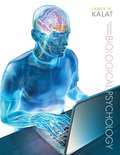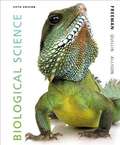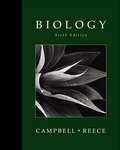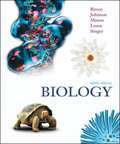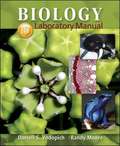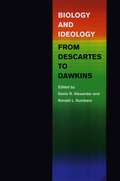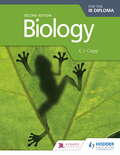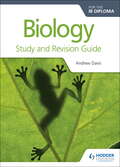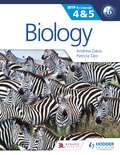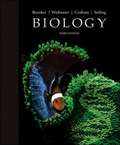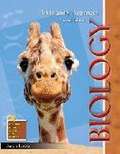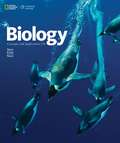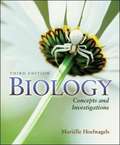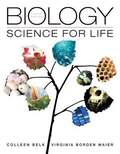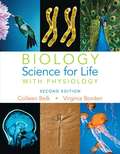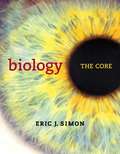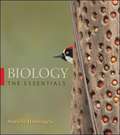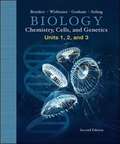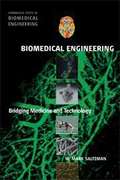- Table View
- List View
Biological Psychology (Eleventh Edition)
by James W. KalatThe most widely used text in its course area, Dr. James W. Kalat's BIOLOGICAL PSYCHOLOGY appeals to students and instructors alike. Throughout all eleven editions, the goal has been to make biological psychology accessible to psychology students, not just to biology majors and pre-meds. The goal has also been to convey the excitement of the search for biological explanations of behavior. Kalat believes that biological psychology is "the most interesting topic in the world," and this text convinces many students--and perhaps you, too--with its clear writing style, amusing anecdotes, and intriguing examples. A media-rich, highly interactive online eBook integrates the text with videos, animations, and an online bio-lab component, making it easier for you to learn.
Biological Science
by Scott Freeman Michael Black Emily Taylor Kim Quillin Lizabeth Allison Greg Podgorski Jon MonroeBiological Science, Fifth Edition contains many new or expanded features, all of them targeted at ways to help students learn to construct their own knowledge and think like biologists. The book provides scaffolding to help students learn at the level called for by the National Academy of Sciences, the Howard Hughes Medical Institute, the American Association of Medical Academies, and the National Science Foundation.
Biology (6th edition)
by Jane B. Reece Neil A. CampbellReflecting the changing landscape of the subject it surveys, this Sixth Edition of BIOLOGY is our most sweeping revision ever. But throughout the revision process, we have kept in mind the two core goals of all earlier editions: to explain the key con¬cepts of biology clearly and accurately within a context of unifying themes, and to help students develop positive and realistic impressions of science as a process of inquiry. These two teaching values evolved in the classroom, and we are obviously gratified that the book's dual emphases on concept-building and the process of science have appealed to the educators and students who have made BIOLOGY the most widely used college science textbook. But with this privilege of sharing biology with so many students comes the responsibility to continue improving the book to serve the biology community even better. Thus, throughout the entire planning and revision process, we visited dozens of campuses to listen to what students and their professors had to say about their biology courses and textbooks. These conversations with faculty and students informed the many improvements you'll find in this Sixth Edition.
Biology (Ninth Edition)
by Peter H. RavenThe ninth edition of this text provides a clear and accessible overview of the key topics in biology, placing the emphasis on evolution and scientific inquiry.
Biology 11th Edition
by Sylvia S. Mader Michael WindelspechtSylvia Mader represents one of the icons of science education. Her dedication to her students, coupled with her clear, concise writing style has benefited the education of thousands of students over the past three decades. Dr. Michael's Windelspecht: The integration of text and the digital world are now complete with the addition of Michael's Windelspecht's expertise in the development of digital learning assets.
Biology Laboratory Manual (Tenth Edition)
by Randy Moore Darrell VodopichThe Biology Laboratory Manual by Vodopich and Moore was designed for an introductory biology course with a broad survey of basic laboratory techniques. The experiments and procedures are simple, safe, easy to perform, and especially appropriate for large classes. Few experiments require more than one class meeting to complete the procedure. Each exercise includes many photographs, traditional topics, and experiments that help students learn about life. Procedures within each exercise are numerous and discrete so that an exercise can be tailored to the needs of the students, the style of the instructor, and the facilities available.
Biology Now
by Anu Singh-Cundy Anne Houtman Megan Scudellari Cindy MaloneA balance of science and story, with a focus on the people doing biology now.Written by a science journalist and teachers with over thirty years experience in the classroom, Biology Now skillfully blends core biology concepts with popular science stories of real people doing science today. These stories capture the human face of biology, highlighting the work of researchers and medical professionals who are making new discoveries every day. The text is accompanied by a wealth of carefully crafted pedagogy that teaches students how to analyze science in the news, interpret data, ask questions, and distinguish between science and pseudoscience.
Biology and Ideology from Descartes to Dawkins
by Ronald L. Numbers Denis R. AlexanderUntil well into the twentieth century neither scientists themselves nor the scholars who studied science linked science with ideology, a term coined in the late eighteenth century and typically employed pejoratively to designate ideas in the use of particular interests. Among the first to connect ideology and science were Karl Marx and his followers, who identified "ideologies" as ideas that served the social interests of the bourgeoisie.
Biology for the IB Diploma Second Edition
by Andrew Davis C. J. CleggProvide clear guidance to the 2014 changes and ensure in-depth study with accessible content, directly mapped to the new syllabus and approach to learning.This second edition of the highly regarded textbook contains all SL and HL content, which is clearly identified throughout. Options are available free online, along with appendices and data and statistics.- Improve exam performance, with exam-style questions, including from past papers- Integrate Theory of Knowledge into your lessons and provide opportunities for cross-curriculum study- Stretch more able students with extension activities- The shift to concept-based approach to learning , Nature of Science, is covered by providing a framework for the course with points for discussion - Key skills and experiments included
Biology for the IB Diploma Study and Revision Guide
by Andrew Davis C. J. CleggStretch your students to achieve their best grade with these year round course companions; providing clear and concise explanations of all syllabus requirements and topics, and practice questions to support and strengthen learning. - Consolidate revision and support learning with a range of exam practice questions and concise and accessible revision notes- Practise exam technique with tips and trusted guidance from examiners on how to tackle questions- Focus revision with key terms and definitions listed for each topic/sub topic
Biology for the IB MYP 4 & 5: By Concept
by Andrew Davis Patricia DeoEndorsed by the IBDrive meaningful inquiry through a unique concept-driven narrative.- Supports every aspect of assessment with opportunities that use the criteria- Gives you easy ways to differentiate and extend learning- Provides a meaningful approach by integrating the inquiry statement in a global context- Develops critical-thinking skills with activities and summative sections rooted in the ATL frameworkThis title is also available in two digital formats via Dynamic Learning. Find out more by clicking on the links at the top of the page.
Biology, 3rd Edition
by Robert J. Brooker Linda Graham Peter Stiling Eric WidmaierThe first and second editions of BIOLOGY, written by Dr. Rob Brooker, Dr. Eric Widmaier, Dr. Linda Graham, and Dr. Peter Stiling, has reached thousands of students and provided them with an outstanding view of the biological world. Now, the third edition has gotten even better! The author team is dedicated to producing the most engaging and current text that is available for undergraduate students who are majoring in biology. The authors want students to be inspired by the field of biology and become critical thinkers. They understand the goal of a professor is to prepare students for future course work, lab experiences, and careers in the sciences. Building on the successes of the first and second editions, the third edition reflects a focus on core competencies and provides a more learner-centered approach. The strength of an engaging and current text is improved with the addition of new pedagogical features that direct the students' learning goals and provide opportunities for assessment, to determine if students understand the concepts.
Biology: Concepts And Applications
by Cecie Starr Lisa Starr Christine A. EversIn the new edition of BIOLOGY: CONCEPTS AND APPLICATIONS, authors Cecie Starr, Christine A. Evers, and Lisa Starr have partnered with the National Geographic Society to develop a text designed to engage and inspire. This trendsetting text introduces the key concepts of biology to non-biology majors using clear explanations and unparalleled visuals. While mastering core concepts, each chapter challenges students to question what they read and apply the concepts learned, providing students with the critical thinking skills and science knowledge they need in life. Renowned for its writing style the new edition is enhanced with exclusive content from the National Geographic Society, including over 200 new photos and illustrations. New People Matter sections in most chapters profile National Geographic Explorers and Grantees who are making significant contributions in their field, showing students how concepts in the chapter are being applied in biological research. Each chapter concludes with an 'Application' section highlighting real-world uses of biology and helping students make connections to chapter content.
Biology: Concepts and Investigations 3rd Edition
by Mariëlle HoefnagelsMariëlle Hoefnagels' passion as a classroom instructor is evident in Biology: Concepts and Investigations, an introductory biology textbook written to explain the general concepts of biology at a level of detail that allows students to understand concepts rather than memorise details. New media integration icons, upgraded PowerPoint presentations, new tutorial animations based on textbook art, upgraded Connect question banks, and adaptive technologies like LearnSmart and Smartbook capitalise on the power of technology to enhance student understanding. Key goals of the book are to: help the student connect the concepts in the book to their everyday lives; show connections between ideas within the chapter and to material they have already studied; teach introductory students how to be more active learners.
Biology: Science for Life
by Colleen Belk Virginia Borden MaierColleen Belk and Virginia Borden Maier have helped students understand biology for more than twenty years in the classroom and over ten years with their popular text, Biology: Science for Life. The thoroughly revised Fifth Edition engages students with new storylines that explore high-interest topics such as binge drinking, pseudoscience, and study drugs.
Biology: Science for Life with Physiology
by Colleen Belk Virginia BordenThe author's experiences of the sciences life such as: Cells, metabolism, and life in the genetics.
Biology: Student Study Guide (Ninth Edition)
by Sylvia S. MaderThe Study Guide is designed to accompany your text, Biology, ninth edition, by Sylvia S. Mader. A number of different approaches are used to help you achieve mastery of the chapter concepts.
Biology: The Core
by Eric J. SimonEric Simon’s Biology: The Core combines a 12-chapter textbook and robust content in Mastering Biology to offer a flexible new teaching and learning package that engages you with concise writing, beautiful and effective visuals, and outstanding interactive digital resources.
Biology: The Essentials
by Mariëlle HoefnagelsHOEFNAGELS: BIOLOGY: THE ESSENTIALS Mariëlle Hoefnagels presents up-to-date information using a scientific approach and relevant examples to illustrate the basic biological concepts. Mariëlle's focus on evolutionary processes and implications aid a cross-disciplinary approach to the study of Biology, which will help students make connections and grasp the importance and relevance of biology in their lives. BIOLOGY EXPLAINED YOUR WAY - In writing this book Mariëlle has maintained a TOTAL FOCUS ON THE STUDENT and what they need to be successful in this course by providing the tools and direction needed to support understanding and learning, not memorizing. Her primary goal has been to simplify the more complicated biological content to the elements that students need to actually understand it. WANT TO DELIVER AN ESSENTIAL OVERVIEW? The early sections of the chapters serve as an overview that introduces the importance and overall result of the process but skips the detail.
Biology: The Unity and Diversity of Life
by Cecie Starr Lisa Starr Ralph Taggart Christine EversWritten by a team of best-selling authors, BIOLOGY: THE UNITY AND DIVERSITY OF LIFE, 14th Edition reveals the biological world in wondrous detail. This text shows and tells the fascinating story of life on Earth, and engages readers with hands-on activities that encourage critical thinking. Chapter opening Learning Roadmaps help students focus on the topics that matter most and section-ending "Take Home Messages" reinforce key concepts. Helpful in-text features include a running glossary, case studies, issue-related essays, linked concepts, self-test questions, data analysis problems, and more. BIOLOGY: THE UNITY AND DIVERSITY OF LIFE, 14th Edition puts the living world of biology under a microscope for readers from all walks of life to analyze, understand, and enjoy!
Biology: The Unity and Diversity of Life (12th edition)
by Cecie Starr Lisa Starr Ralph Taggart Christine EversThe 12th edition of this undergraduate text seeks to make students aware of the connection between molecular change, evolution, and students' own lives. To achieve this goal, the text features essays on current controversial issues, links to concepts within and between chapters, two-page concept spreads, and problem solving examples and experiments that encourage students to think critically. Other changes include reorganized and rewritten material on areas such as energy flow and stem cell research. Author information is not given.
Biology: Units 1,2, and 3
by Eric P. Widmaier Robert J. Brooker Linda Graham Peter StilingThis Volume of Biology covers Chemistry, Cell Biology, and Genetics. The Brooker et. al text features an evolutionary focus with an emphasis on scientific inquiry.
Biomedical Engineering for Global Health
by Rebecca Richards-KortumCan technology and innovation transform world health? Connecting undergraduate students with global problems, Rebecca Richard-Kortum examines the interplay between biomedical technology design and the medical, regulatory, economic, social and ethical issues surrounding global health. Driven by case studies, including cancer screening, imaging technologies, implantable devices and vaccines, students learn how the complexities and variation across the globe affect the design of devices and therapies. A wealth of learning features, including classroom activities, project assignments, homework problems and weblinks within the book and online, provide a full teaching package. For visionary general science and biomedical engineering courses, this book will inspire students to engage in solving global issues that face us all.
Biomedical Engineering: Bridging Medicine and Technology
by W. Mark SaltzmanThis book is an introduction to biomedical engineering, starting from the basics and demonstrating the engineering principles that are used to create new diagnostic methods and therapies for human disease. Although biomedical engineering is a relatively new field of study, it will impact almost every person in the world.
